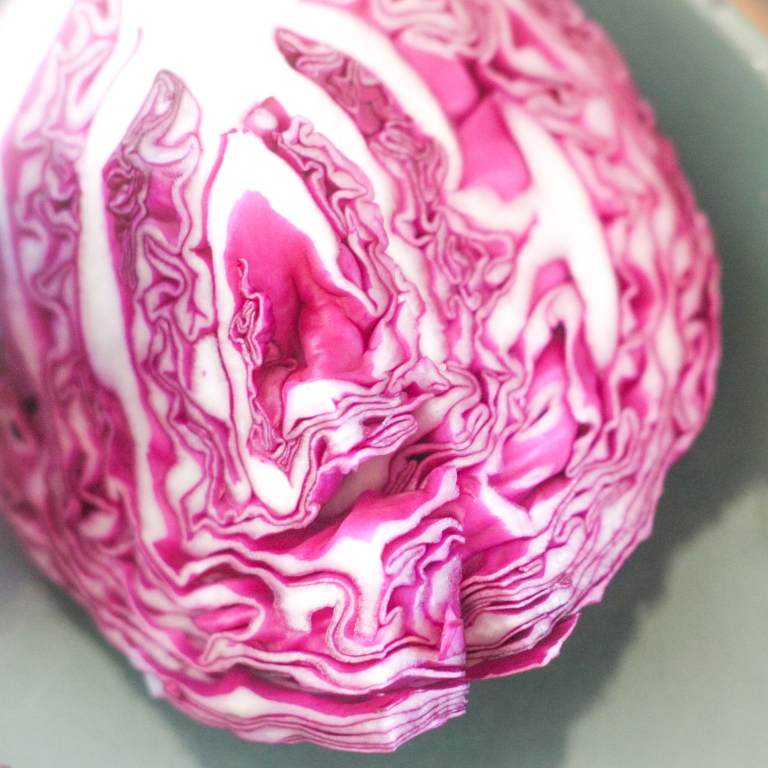This is not, strictly speaking, a recipe from the Middle East or North Africa. But I do use it to balance a meal in ways inspired by the traditions of medieval Arab cookery, in which presentation and color were key elements for setting a sumptuous table.
It’s a simplified version of a Smitten Kitchen recipe, and one of my favorite kinds of dishes: the key lies in the combination of a few unlikely ingredients that work beautifully together (and look good, too): dates, red cabbage, and feta cheese. (Note: a friend pointed out that this is not the first time I have gotten excited about a combination like this; in summertime this combination works well with zucchini and yellow squash, too.)
For the recipe, and more about why color mattered to medieval Islamicate dining, read on.

Lilia Zaouali, whose excellent book on medieval Arabic cuisine I have referenced and cooked from before here on the blog, writes that in medieval dining in the Arab world,
“The appearance of food in the presentation of dishes was important, and enticing colors were desired. Before the importation of artificial coloring agents, “coriander [cilantro] water” was used for green coloring and, in Tunisia until not very long ago, “spinach water.” Saffron and turmeric were used to impart a yellow color. Raw pomegranate seeds, which resemble precious stones, were used for the color red. Fennel-flower or nigella (Nigella sativa, also sometimes called black cumin) seeds, sprinkled on fresh cheese, created the impression of black dots on a white background. Egg–yolk and albumen–reproduced the colors of the poet’s narcissus (Narcissus poeticus) with its white petals and yellow center.” (p. 53)
I love a table of contrasting bright colors, especially when they’re all natural hues. The importance of color and appearance in food presentation in the specific era Zaouali discusses is linked in part to an overall understanding of the body in the medieval Islamicate world. In that framework, inputs from all the senses––not just sight but smell and taste and feel––were assumed to impact a body and soul’s well-being. (For more on how that worked in feasting situations, why it matters, and a whole lot more information about narcissus, check out this article I wrote about a bunch of edible flowers purchased in a Baghdad market in The Thousand and One Nights). A particularly striking dish, Zaouali writes, could provoke a sense of “astonishment and wonder” with the right combination of aroma, appearance, and color (p. 39).
I like to think that this recipe delivers something along those lines: a pop of purple, the zing of lemon juice and feta (can’t you feel your mouth watering already?) and a hint of sweetness (and y’all know how I feel about combining sweet & sour). Recently I’ve paired it with Moroccan lemon & olive chicken tajine (lately my favorite version of this recipe is Choumicha’s) and m’sakkhan. But it also keeps well for several days and is great to throw on a sandwich to liven it up a bit. If you still need a reason to make this, it’s great for big holiday family meals, because you can put almost anyone in the corner of your kitchen with a knife and the ingredients and ask them to put it together without too much supervision.

Pop of Color Cabbage
adapted from Smitten Kitchen
Ingredients for 6-8 servings:
Half a red cabbage, sliced very thinly
4-5 ounces of good crumbly feta cheese
Handful of chopped dates (for American consumers: I like the Sun-Maid chopped, not pitted, dates. They’re a bit drier and easier to work with than even regular pitted dates), chopped very finely
Juice of 1-2 lemons
Olive oil
Salt and pepper
Combine cabbage, feta, and dates. Add juice of one lemon, a tablespoon of olive oil, and salt and pepper to taste. Toss very well so that the dates and feta coat the cabbage more or less evenly, and then keep adding lemon juice as needed.


Wow this looks really good!